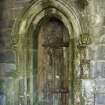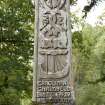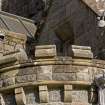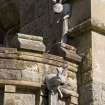Pricing Change
New pricing for orders of material from this site will come into place shortly. Charges for supply of digital images, digitisation on demand, prints and licensing will be altered.
Scheduled Maintenance Notice
Please be advised that this website will undergo scheduled maintenance starting on Thursday, 30th January at 11:00 AM and will last until Friday, 31st January at 10:00 AM.
During this time, the site and certain functions may be partially or fully unavailable. We apologise for any inconvenience this may cause.
Lochawe, St Conan's Church
Architectural Fragment(S) (Medieval), Church (20th Century), War Memorial(S) (20th Century), Bell (Mid 19th Century) (1843)
Site Name Lochawe, St Conan's Church
Classification Architectural Fragment(S) (Medieval), Church (20th Century), War Memorial(S) (20th Century), Bell (Mid 19th Century) (1843)
Alternative Name(s) Loch Awe; St Conan's Kirk; War Memorial Plaques
Canmore ID 112354
Site Number NN12NW 21
NGR NN 11595 26743
Datum OSGB36 - NGR
Permalink http://canmore.org.uk/site/112354
First 100 images shown. See the Collections panel (below) for a link to all digital images.
- Council Argyll And Bute
- Parish Ardchattan And Muckairn (Argyll And Bute)
- Former Region Strathclyde
- Former District Argyll And Bute
- Former County Argyll
Unique and somewhat enchanting and eccentric church building, designed by Walter Douglas Campbell, a wealthy amateur architect and skilled woodworker. Legend has that Campbell began the church so that his mother did not have to travel all the way to Dalmally from the house he had built on the island of Innis Chonain. Begun in 1881-86, the first period of building was a small cruciform church consisting of the modern Nave and part of the Choir. Campbell extended the church from 1907 until his death in 1914, wherafter his sister Helen continued the building until her death in 1927 and the current church was completed in 1930 by Trustees.
Loch Awe, St Conan's church.
ARCHITECT: Walter Campbell.
EXTERNAL REFERENCE:
Strathclyde Regional Archives
Account books for building church.
The first church was built and designed on this site by W D Campbell between 1881 and 1886 and now occupies what is now the nave. The church was completed under the supervision of Campbell's sister who died in 1927, the church being dedicated in 1930.
The church incorporates many different styles both in the interior and in the decoration of the exterior. Fragments of Iona Abbey are incorporated into the N wall of the S aisle, and a window from St Mary's Parish Church, South Leith is built into the S wall of the Bruce Chapel. An unusual object is also preserved in the Bruce Chapel: a bell founded in 1843 for Skerryvore Lighthouse (NL82NW 1).
Information from RCAHMS, December 1996.
The church was photographed on behalf of the RCAHMS Listed Buildings Survey in 2007.
Online Gallery (1306 - 1329)
The year 2014 sees the 700th anniversary of the Battle of Bannockburn, in which the army of Robert I of Scotland defeated that of Edward II of England. The battle marked a major turning point in the long, drawn-out struggle of the Wars of Independence.
The Wars have had a lasting influence upon all the nations of the United Kingdom and upon the national story. Each age has seen fit to commemorate the events in its own way: through the perpetuation of the genuine historical associations of buildings and places and also through the endowment of others with improbable or fanciful traditions. Where past generations allowed its historic buildings to decay and disappear, later generations began to value and actively preserve these for their associations. Where an event lacked a tangible reminder, as at Kinghorn where Alexander III was killed in a riding accident, a commemorative monument would be erected to act as a focus. The Wars of Independence predate the fashion for accurate portraiture: the weathered, generic military effigy of Sir James Douglas is one of the few to survive in Scotland. Later centuries saw a need and supplied it by a crowd of images of its historic heroes, William Wallace and Robert the Bruce, each depicted according to contemporary taste and imagination. The opening of the new heritage centre at Bannockburn takes this into a new dimension, through the use of three-dimensional, digital technology.
RCAHMS Collections hold many images of these buildings and locations from battlefields, castles and churches, to the many commemorative monuments erected in later years. This gallery highlights a selection of these, including antiquarian sketches, photographic and drawn surveys, and architectural designs.
Field Visit (June 1971)
NN 115 267. St Conan's Church, a large building of eclectic style erected between 1881 and 1930 at the expense of, and largely to the designs of, Walter D Campbell of Blythswood, incorporates a number of imported architectural fragments and other fittings. These include the following:
(1) The 15th-century W window of St Mary's Parish Church, South Leith, removed from that building at the restoration of 1848 and re-erected here, with the original outer face turned inwards, in the Swall of the Bruce chapel (A measured drawing by T Ross was published in TSES vii (1921-4), part ii, opp. p. 79.). The arch-head of the six-light window (Pl. 120E) is filled with flamboyant tracery, and the jambs are wrought with alternating ovolo and hollow-chamfer mouldings. The stops of the filleted hood-mould are carved with human heads, now greatly worn. The original outer faces of the mullions are wrought with hollow chamfers and filleted rolls, while internally the mullions and jambs are chamfered.
(2) Portions of the original tracery of the E window of the S choir-aisle of Iona Abbey (Pl. 120F), now built into a recess in the N wall of the S nave-aisle. The original window was restored in 1904, at the expense of Miss Campbell of Blythswood (TGAS, new series, v (1905-8), 86-7), and the fragments preserved are greatly weathered. They comprise the cusped heads of the two lower lights, a wheel composed of six trefoil lights, and a small quatrefoil opening at the apex of the arch-head.
(3) The head of a lancet-window of 13th-century type, rebated externally but not chamfered, which lies at the W end of the nave. This is of doubtful authenticity, and may have been carved for use in the present building, like many fragments preserved in the gardens near the church.
(4) A bell (Pl. 120G), 0'76 m in diameter, now kept in the Bruce chapel, bearing the inscription: THOMAS MEARS FOUNDER LONDON 1843 / NORTH LIGHTHOUSES / IN SALUTEM OMNIUM. This is said (Martin 1950, 11) to have come from Skerryvore Lighthouse, and was evidently one of the three bells purchased, at a total cost of £107 6s 3d, for use in foggy weather (Stevenson 1848, 381).
Also preserved in the Bruce Chapel are two wooden screens, each of four bays. These are said to be from Eton College Chapel (Martin, loc cit), but are of modern workmanship.
RCAHMS 1975, visited June 1971
Publication Account (1985)
St Conan's Church- Lochawe, is a monument to the skills and determination of Waiter Douglas Campbell, who had built a mansion on the island of Innis Chonain in Loch Awe. Campbell designed and built the first church on the site between 1881 and 1886, occupying what is now the nave, but he envisaged a more imposing structure; he devoted himself to the design and building of the church between 1907 and his death in 1914. The completion of the task was supervised by his sister Helen and, although she died in 1927, the church was at last dedicated in 1930.
The church is spacious and light; although designed to juxtapose many different styles both in the interior and in the decoration of the exterior, it is a memorable place to visit. Fragments from Iona Abbey are incorporated into the north wall of the south aisle, and a window from St Mary's Parish Church, South Leith, is built into the south wall of the Bruce Chapel. An unusual object is also preserved in the Bruce Chapel: a bell founded in 1843 for Skerryvore Lighthouse (no. 13).
Information from ‘Exploring Scotland’s Heritage: Argyll and the Western Isles’, (1985).
Photographic Survey (2006 - 2007)
Photorgaphed by the Listed Buildings Area Survey, Argyll upgrade programme.
RCAHMS (CAJS) 2012.














































































































































































































